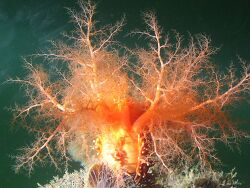Info
(Brandt, 1835)
C. miniata ranges in length from 10 to 25 cm. The body is reddish brown or pinkish brown (but may be pinkish white to purple) with bright orange oral tentacles. The species' body wall is thick and tough. There are 10 equally sized oral tentacles that are branched. The tube feet are arranged in definite rows, but other podia may occasionally occur between rows. Length to 25 cm.
C. miniata uses its oral tentacles to trap small organisms and detritus suspended in the water. Undisturbed animals may have the body curved into a U shape, so that both the mouth and anus are exposed to moving water. The tentacles can retract rapidly if disturbed. C. miniata is predated on by the sea stars Dermasterias imbricata, Solaster stimpsoni, and S. endeca. Kelp greenling fish sometimes nip the oral tentacles. Tests have shown that neither the body wall nor the viscera are toxic to fish. Eggs, embryos, and larvae are orange in color. The larvae have been found in the plankton of the Puget Sound during the months of March and April.
This species sometimes contains an internal parasitic gastropod, Thyonicola dogieli, which appears as a coiled, egg-filled tube.
Source: EOL
Classification: Biota > Animalia (Kingdom) > Echinodermata (Phylum) > Echinozoa (Subphylum) > Holothuroidea (Class) > Dendrochirotida (Order) > Cucumariidae (Family) > Cucumaria (Genus) > Cucumaria miniata (Species)
C. miniata ranges in length from 10 to 25 cm. The body is reddish brown or pinkish brown (but may be pinkish white to purple) with bright orange oral tentacles. The species' body wall is thick and tough. There are 10 equally sized oral tentacles that are branched. The tube feet are arranged in definite rows, but other podia may occasionally occur between rows. Length to 25 cm.
C. miniata uses its oral tentacles to trap small organisms and detritus suspended in the water. Undisturbed animals may have the body curved into a U shape, so that both the mouth and anus are exposed to moving water. The tentacles can retract rapidly if disturbed. C. miniata is predated on by the sea stars Dermasterias imbricata, Solaster stimpsoni, and S. endeca. Kelp greenling fish sometimes nip the oral tentacles. Tests have shown that neither the body wall nor the viscera are toxic to fish. Eggs, embryos, and larvae are orange in color. The larvae have been found in the plankton of the Puget Sound during the months of March and April.
This species sometimes contains an internal parasitic gastropod, Thyonicola dogieli, which appears as a coiled, egg-filled tube.
Source: EOL
Classification: Biota > Animalia (Kingdom) > Echinodermata (Phylum) > Echinozoa (Subphylum) > Holothuroidea (Class) > Dendrochirotida (Order) > Cucumariidae (Family) > Cucumaria (Genus) > Cucumaria miniata (Species)







 Ed Bierman, USA
Ed Bierman, USA












